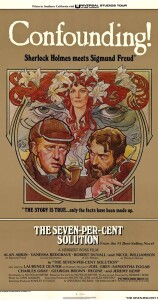 Craig Clarke penned this review.
Craig Clarke penned this review.
Seven-Per-Cent Solution describes the events of Sherlock Holmes’ life between “The Final Problem” and “The Empty House”, as well as explaining Holmes’ dislike of women and his hate for Professor Moriarty (Holmes’ mathematics tutor and now “the Napoleon of crime,” Holmes insists).
When the story begins, Holmes is deep in the throes of his cocaine addiction. Watson comes for a visit after a long absence to find Holmes paranoid, pale, and suspicious even of his old friend. So, through some deception and with the help of Holmes’ brother, Mycroft (Charles Gray, who reprised the role on the Granada television series), Watson gets Holmes to Vienna to see Sigmund Freud, who proceeds to attempt to cure Holmes of his addiction to cocaine as well as psychoanalyzing him via hypnosis. During his treatment, Holmes is also attempting to solve a kidnapping case involving famous stage actress Lola Devereaux (Vanessa Redgrave, in a minimal but pivotal role).
I’ve revisited this often and it’s always pure fun. Nicol Williamson is a perfect Holmes and is particularly good at portraying the withdrawal stages of Holmes’ cure. Robert Duvall is nearly unrecognizable as Dr. Watson, and Alan Arkin is quite good as Freud (although his accent isn’t always perfect).
Nicholas Meyer adapted The Seven-Per-Cent Solution from his own novel, and he and director Herbert Ross turn out a fine Holmes pastiche. The book is even better, capturing the language as well as the different mannerisms of the characters. Meyers’ other outings were not as successful and can be skipped, but this one is a must-see (and read) for fans of Sir Arthur Conan Doyle’s best-known creation.
(Universal, 1976)
